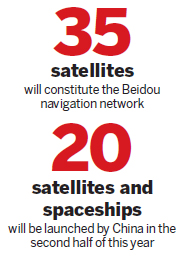Society
GPS-style map system takes off
By Xin Dingding (China Daily)
Updated: 2011-04-11 07:06
 |
Large Medium Small |
BEIJING - China successfully launched its eighth Beidou (Compass) navigation satellite on Sunday, ensuring the basic system for its indigenous satellite navigation and positioning network is in place.
|
![A Long March-3A carrier rocket bearing the eighth Beidou (Compass) navigation satellite takes off at 4:47 am on Sunday from the Xichang Satellite Launch Center in Southwest China’s Sichuan province. [Photo/Xinhua] GPS-style map system takes off](../../images/attachement/jpg/site1/20110411/002170196e1c0f0c79c80d.jpg) A Long March-3A carrier rocket bearing the eighth Beidou (Compass) navigation satellite takes off at 4:47 am on Sunday from the Xichang Satellite Launch Center in Southwest China’s Sichuan province. [Photo/Xinhua] |
Beidou is being developed to rival the United States-developed GPS, the European Union's Galileo and Russia's Global Navigation Satellite System, and is aimed at allowing travelers, drivers and military officials to accurately know their locations.
A Long March-3A carrier rocket bearing the satellite took off at 4:47 am on Sunday from the Xichang Satellite Launch Center in Southwest China's Sichuan province, according to a statement on the Beidou navigation system's official website, beidou.gov.cn.
After time for testing and adjusting, the satellites will be prepared to offer basic navigation services for most parts of the country, the statement said, without saying when the services will start.
It is an improvement compared to the experimental Beidou navigation network that China built by launching four navigation satellites between 2000 and 2003, which was known for its important role in disaster relief work, said Pang Zhihao, a researcher and deputy editor-in-chief of the monthly magazine Space International.
"Satellites in inclined orbits can observe things from a different angle and are able to see things shielded by trees or high-rises that satellites in geostationary orbits may not see," he said.

"The increase in the number of navigation satellites and the two various orbits have together made the under-construction Beidou navigation system able to provide more accurate navigation and positioning services."
The satellite launched on Sunday is also the first space launch in China this year.
Earlier media reports said China plans to launch at least 20 satellites and spaceships, including the Tiangong-1 space module and Shenzhou VIII spaceship during the latter half of this year for China's first unmanned rendezvous and docking, and four Beidou satellites.
Last year, China launched 20 satellites on top of 15 launch vehicles, ranking second in the world in terms of space launches after the US.
Now that the basic shape of the Beidou navigation network has been formed, future launches will make the network "stronger" and able to provide "around-the-clock, stable" service throughout the Asia-Pacific region, said Wu Dong, director of the navigation project office at the China Aerospace Science and Technology Corporation.
According to Pang, the upcoming Beidou satellites will likely be launched to cover closer orbits and nestle some 20,000 kilometers above the Earth's surface. The current Beidou satellites in both the geostationary orbit and inclined geosynchronous orbit are 36,000 km away.
China aims to have at least 10 Beidou navigation satellites in orbit before 2012 to cover the Asia-Pacific region and complete the system by 2020.
The system will provide service with high precision and credibility for industries and sectors including mapping, fishery, transportation, meteorology and telecommunications.
| 分享按钮 |



